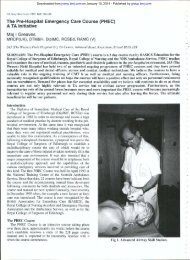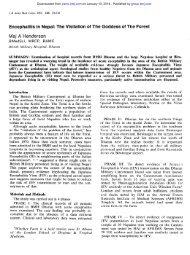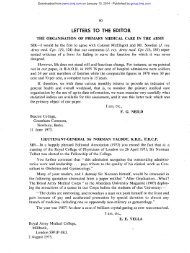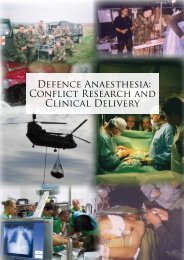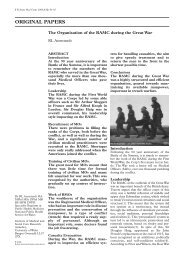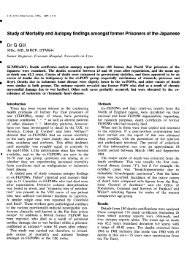Novel Haemostatic Dressings - Journal of the Royal Army Medical ...
Novel Haemostatic Dressings - Journal of the Royal Army Medical ...
Novel Haemostatic Dressings - Journal of the Royal Army Medical ...
Create successful ePaper yourself
Turn your PDF publications into a flip-book with our unique Google optimized e-Paper software.
20. Marris E. Four years in Iraq: <strong>the</strong> war against wounds. Nature. 2007; 446: 369-<br />
371<br />
21. Hursey K 510(k) QuikClot ® premarket notification summary Newington CT<br />
2001. Food and Drug Administration. May 23 2002 [cited 2009 July 14]<br />
Available from: http://www.accessdata.fda.gov/cdrh_docs/pdf/K013390.pdf<br />
22. Alam HB, Uy GB, Miller D et al. Comparative analysis <strong>of</strong> hemostatic agents<br />
in a swine model <strong>of</strong> lethal groin injury. J Trauma. 2003; 54: 1077-1082<br />
23. Alam HB, Chen Z, Jaskille A et al. Application <strong>of</strong> a Zeolite hemostatic agent<br />
achieves 100% survival in a lethal model <strong>of</strong> complex groin injury in swine. J<br />
Trauma. 2004; 56: 974-983<br />
24. Baker SE, Sawvel AM, Zheng N, Stucky GD. Controlling bioprocesses with<br />
inorganic surface: layered clay hemostatic agents. Chem Mater. 2007; 19:<br />
4390-4392<br />
25. US <strong>Army</strong> <strong>Medical</strong> Materiel Agency. Hot Topics. Last updated 11 September<br />
2009 [cited 2009 September 15] Available<br />
from:http://www.usamma.army.mil/hot_topics.cfm<br />
26. Arnaud F, Hammett M, Philbin N, Scultetus A, McCarron R, Freilich D.<br />
Hematologic effects <strong>of</strong> recombinant factor VIIa combined with hemoglobinbased<br />
oxygen carrier-201 for prehospital resuscitation <strong>of</strong> swine with severe<br />
uncontrolled hemorrhage due to liver injury. Blood Coagul Fibrinolysis. 2008;<br />
19: 669-677<br />
27. Acheson EM, Kheirabadi BS, Dick EJ, Holcomb JB. Comparison <strong>of</strong><br />
hemorrhage control agents applied to lethal extremity arterial hemorrhages in<br />
swine. J Trauma. 2005; 59: 865-875<br />
28. Wright JK, Kalns J, Wolf EA et al. Thermal Injury resulting from application<br />
<strong>of</strong> a granular mineral hemostatic agent. J Trauma. 2004; 57: 224-230<br />
29. Neuffer MC, McDivitt J, Rose D, King K, Cloonan CC, Vayer JS. Hemostatic<br />
dressings for <strong>the</strong> first responder: a review. Mil Med. 2004; 169: 716-720<br />
30. Arnaud F, Tomori T, Saito R, McKeague A, Prusaczyk WK, McCarron R.<br />
Comparative efficacy <strong>of</strong> granular and bagged formulations <strong>of</strong> <strong>the</strong> hemostatic<br />
agent QuikClot ® . J Trauma. 2007; 63: 775-782<br />
31. Packard RV. 510(k0 Premarket notification + Wallingford CT 2006. Food and<br />
Drug Administration. July 19 2006 [cited July 30 2009] Available from:<br />
http://www.accessdata.fda.gov/cdrh_docs/pdf6/K061767.pdf<br />
32. Rhee P, Brown C, Martin M et al. QuikClot® use in trauma for hemorrhage<br />
control: case series <strong>of</strong> 103 documented uses. J Trauma. 2008; 64: 1093-1099<br />
33. Wright FL, Hua HT, Velmahos G, Thoman D, Demitriades D, Rhee P.<br />
Intracorporeal use <strong>of</strong> <strong>the</strong> hemostatic agent QuickClot in a coagulopathic<br />
patient with combined thoracoabdominal penetrating trauma. J Trauma.<br />
2004; 56: 205-208<br />
34. Evriviades D. Successful intra-corporeal use <strong>of</strong> QuikClot ® observed at RCDM<br />
in UK serviceman. Personal communication September 2009.<br />
35. Medafor Minneapolis, MN, USA. Hemostatic polymer technologies. August<br />
1 2002 [cited 2009 August 13] Available from:<br />
http://www.medafor.com/mediacenter/020801release.html<br />
36. Velmahos G, Tabbara M, Spaniolas K et al. Self-expanding hemostatic polymer<br />
for control <strong>of</strong> exsanguinating extremity bleeding. J Trauma. 2009; 66: 984-988<br />
37. Ward KR, Tiba H, Holbert WH et al. Comparison <strong>of</strong> a new hemostatic agent<br />
to current combat hemostatic agents in a swine model <strong>of</strong> lethal extremity<br />
arterial hemorrhage. J Trauma. 2007; 63: 276-284<br />
38. Kheirabadi BS, Edens JW, Terrazas IB et al. Comparison <strong>of</strong> new hemostatic<br />
granules/powders with currently deployed hemostatic products in a lethal<br />
model <strong>of</strong> extremity arterial hemorrhage in swine. J Trauma. 2009; 66: 316-328<br />
39. US <strong>Army</strong> <strong>Medical</strong> Materiel Agency Information Paper. Description <strong>of</strong> Combat<br />
Gauze TM and WoundStat TM hemostatic agents 18 September 2008 [cited 2009<br />
September 4]. Available<br />
from:http://www.usamma.army.mil/assets/docs/INFO%20PAPER%20-<br />
%20%20CG%20and%20WS_18Sept2008%20-%20Web.pdf<br />
40. Cavallaro G. WoundStat TM found to be potentially hazardous. <strong>Army</strong> Times.<br />
2009 April 22 [cited 2009 August 20] Available from:<br />
http://www.armytimes.com/news/2009/04/army_woundstattm_042009w/<br />
41. US <strong>Army</strong> <strong>Medical</strong> Materiel Agency. Traumacure / WoundStat TM / Immediate<br />
permanent suspension / DSCP 09-217[letter]. All <strong>Army</strong> Activity Message 29<br />
July 2009<br />
42. Wedmore I, McManus JG, Pusateri A, Holcomb JB. A special report on <strong>the</strong><br />
chitosan-based hemostatic dressing: experience in current combat operations. J<br />
Trauma. 2006; 60: 655-658<br />
43. US Department <strong>of</strong> Defense. Washington DC. DefenseLink: contracts for<br />
Friday, 9 July 2004 [cited 2009 August 20] Available from:<br />
http://www.defenselink.mil/contracts/contract.aspx?contractid=2800<br />
44. Brandenberg G, Leibrock LG, Shuman R, Malette M, Quigley H. Chitosan:<br />
a new topical hemostatic agent for diffuse capillary bleeding in brain tissue.<br />
Neurosurgery. 1984; 15: 9-13<br />
45. Cole DS, Conolly RJ, Chan MW. A pilot study evaluating <strong>the</strong> efficacy <strong>of</strong> a<br />
fully acetylated poly-N-acetyl glucosamine membrane formulation as a topical<br />
hemostatic agent. Surgery. 1999; 126: 510-517<br />
46. HemCon ® <strong>Medical</strong> Technologies Portland OR. How HemCon ® dressings<br />
work. [cited 2009 August 20] Available from:<br />
http://www.hemcon.com/EducationCenter/HowHemCon<strong>Dressings</strong>Work.asp<br />
x<br />
47. Thatte HS, Zagarins S, Amiji M, Khuri S. Poly-N-acetyl glucosaminemediated<br />
red blood cell interactions. J Trauma. 2004; 57: S7-S12<br />
48. Burkatovskaya M, Tegos GP, Swietlik E, Demidova TN, Castano AP, Hamblin<br />
MR. Use <strong>of</strong> a chitosan bandage to prevent fatal infections developing from<br />
highly contaminated wounds in mice. Biomaterials. 2006; 27: 4157-4164<br />
49. Stone CA, Wright H, Clarke T, Powell R, Deveraj VS. Healing at skin graft<br />
donor sites dressed with chitosan. Br J Plastic Surgery. 2000; 53: 601-606<br />
50. Pusateri AE, McCarthy SJ, Gregory KW et al. Effect <strong>of</strong> a Chitosan-based<br />
hemostatic dressing on blood loss and survival in a model <strong>of</strong> severe venous<br />
hemorrhage and hepatic injury in swine. J Trauma. 2003; 54: 177-182<br />
51. Kheirabadi BS, Pusateri A, Sondeen JL, Delgado AV. RTO HFM Symposium<br />
on "Combat Casualty Care in Ground Based Tactical situations Development<br />
<strong>of</strong> hemostatic dressings for use in Military Operations. 2004; St Pete Beach FL.<br />
2004.<br />
52. Englehart MS, Cho SD, Tieu BH et al. A novel highly porous silica and<br />
chitosan-based hemostatic dressing is superior to HemCon ® and gauze<br />
sponges. J Trauma. 2008; 65: 884-892<br />
53. Kheirabadi BS, Acheson EM, Sondeen JL, Ryan KL, Holcomb JB. Hemostatic<br />
effect <strong>of</strong> two advanced dressings in an aortic hemorrhage model in swine. J<br />
Trauma. 2004; 57: 439<br />
54. Sambasivan CN, Cho D, Zink KA, Differding JA, Schreiber MA. A highly<br />
porous silica and chitosan-based hemostatic dressing is superior in controlling<br />
hemorrhage in a severe groin injury model in swine. Am J Surg. 2009; 197:<br />
576-580<br />
55. Kozen BG, Kircher SJ, Henao J, Godinez FS, Johnson AS. Comparison <strong>of</strong><br />
CELOX TM , HemCon ® and QuikClot ® . Acad Emerg Med. 2008; 15: 74-81<br />
56. Brown MA, Daya MR, Worley JA. Experience with chitosan dressings in a<br />
civilian EMS system. J Emerg Med. 2009; 37: 1-7<br />
57. Rang HP, Dale MM. Pharmacology. 2nd Ed. London: Churchill Livingstone;<br />
1991.<br />
58. Bassadona G, Lo D. A novel kaolin coated hemostatic gauze improves<br />
hemostasis both in-vitro and in-vivo. Special Operations <strong>Medical</strong> Society.<br />
2007; Abstract 11<br />
59. Kendrick DB. Blood program in World War II by-products <strong>of</strong> plasma<br />
fractionation. Blood Program World War II. 1989: 363-368<br />
60. Jackson MR. Fibrin sealants in surgical practice: an overview. Am J Surg. 2001;<br />
182: S1-S7<br />
61. Joch C. The safety <strong>of</strong> fibrin sealants. Cardiovasc Surg. 2003; 11 Suppl 1: 23-<br />
28<br />
62. Pusateri A, Kheirabadi BS, Delgado AV et al. Structural design <strong>of</strong> <strong>the</strong> dry fibrin<br />
sealant dressing and its impact on <strong>the</strong> hemostatic efficacy <strong>of</strong> <strong>the</strong> product. J<br />
Biomed Mat Res. 2004; 70B: 114-121<br />
63. Pusateri A, Holcomb JB, Harris R, Charles NC, Beall LD, Hess JR. Effect <strong>of</strong><br />
fibrin bandage concentration on blood loss after grade V liver injury in swine.<br />
Mil Med. 2001; 166: 217-222<br />
64. Holcomb JB, MacPhee M, Hetz S, Harris R, Pusateri A, Hess JR. Efficacy <strong>of</strong><br />
a dry fibrin sealant dressing for hemorrhage control after ballistic injury. Arch<br />
Surg. 1998; 133: 32-35<br />
65. Jackson MR, Friedman SA, Carter AJ et al. Hemostatic efficacy <strong>of</strong> a fibrin<br />
sealant-based topical agent in a femoral artery injury model: a randomized,<br />
blinded, placebo-controlled study. J Vasc Surg. 1997; 26: 274-280<br />
66. Holcomb JB, Pusateri AE, Harris AE et al. Effect <strong>of</strong> dry fibrin sealant dressings<br />
versus gauze packing on blood loss in grade V liver injuries in resuscitated<br />
swine. J Trauma. 1999; 46: 49-57<br />
67. Sondeen JL, Pusateri A, Coppes VG, Gaddy CE, Holcomb JB. Comparison <strong>of</strong><br />
10 different hemostatic dressings in an aortic injury. J Trauma. 2003; 54: 280-<br />
285<br />
68. Kheirabadi BS, Acheson EM, Deguzman R et al. The potential utility <strong>of</strong> fibrin<br />
sealant dressing in repair <strong>of</strong> vascular injury in swine. J Trauma. 2007; 62: 94-<br />
103<br />
69. Eastridge BJ, Jenkins D, Flaherty S, Schiller H, Holcomb JB. Trauma system<br />
development in a <strong>the</strong>ater <strong>of</strong> war: experiences from Operation Iraqi Freedom<br />
and Operation Enduring Freedom. J Trauma. 2006; 61: 1366-1373<br />
70. O'Reilly D, Konig T, Tai N. Field trauma care in <strong>the</strong> 21st century. J R <strong>Army</strong><br />
Med Corps. 2008; 154: 260-264<br />
71. American College <strong>of</strong> Surgeons; Committee on Trauma American College <strong>of</strong><br />
Surgeons. Resources for optimal care <strong>of</strong> <strong>the</strong> injured patient. Chicago (USA);<br />
2006<br />
314 JR <strong>Army</strong> Med Corps 155(4): 309-314



